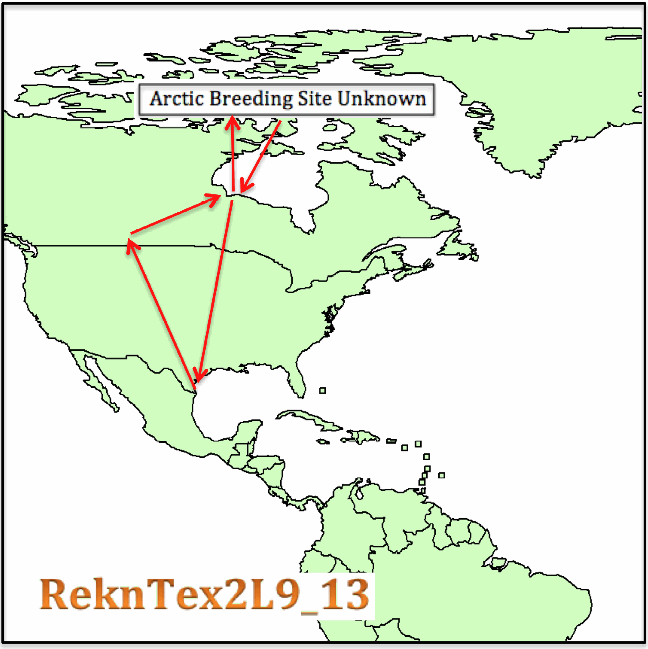Calidris canutus (Rekn, Red Knot) Texas, USA
Project Name: Texas Coastal Bend Bays & Estuaries Program
Correspondent researcher: David Newstead dnewstead@cbbep.org
Researchers: Larry Niles, David Newstead, Ron Porter, Joanna Burger
Bibliographic citation: Newstead, D.J., Niles, L.J., Porter, R.R., Dey, A.D., Burger, J. & Fitzsimmons, O.N. 2013. Geolocation reveals mid-continent migratory routes and Texas wintering areas of Red Knots Calidris canutus rufa. Wader Study Group Bull. 120(1): 53-59.
 ReknChu176_1112: Typical migration
ReknChu176_1112: Typical migration
09oct12 deployed Texas, N26.7xW97.3
19may13 left Texas, 222 days later
21may13 arrived Saskatchewan, near N49.9xW106.7
03jun13 left Saskatchewan, stayed 13 days
05jun13 arrived Nelson River, N58.0xW92.8
13jun13 left Nelson region, stayed 8 days
breeding occurred above the arctic circle, stayed north 32 days, incubation failed after just 3 days, no second clutch
17jul13 arrived Nelson River, southbound
31jul13 left Nelson River, stayed 14 days
03aug13 arrives back in Texas again, near N26.0xW98.1
Route variability of the Texas wintering flock
One red knot flew directly into and out of the Arctic from Texas without stopovers. The southbound routes looping east near the Atlantic coast were nonstop until Louisiana, where stops lasted only 2 to 3 days before continuing to Texas.

Texas as a stopover for South American wintering Red Knots

Of 28 recovered geolocators, 24 spent their entire non-breeding season in Texas. The other 4 used Texas as a stopover from their wintering grounds in Panama, Peru and Argentina.
This knot made an amazing nonstop fight of 6 days (8100km) from Chiloe, Argentina, to Texas, then continued on to Alaska to breed. The northbound route crossed the Central U.S., but southbound it followed the Pacific coast.
One other knot went to Alaska to breed, from Panama via Texas.
